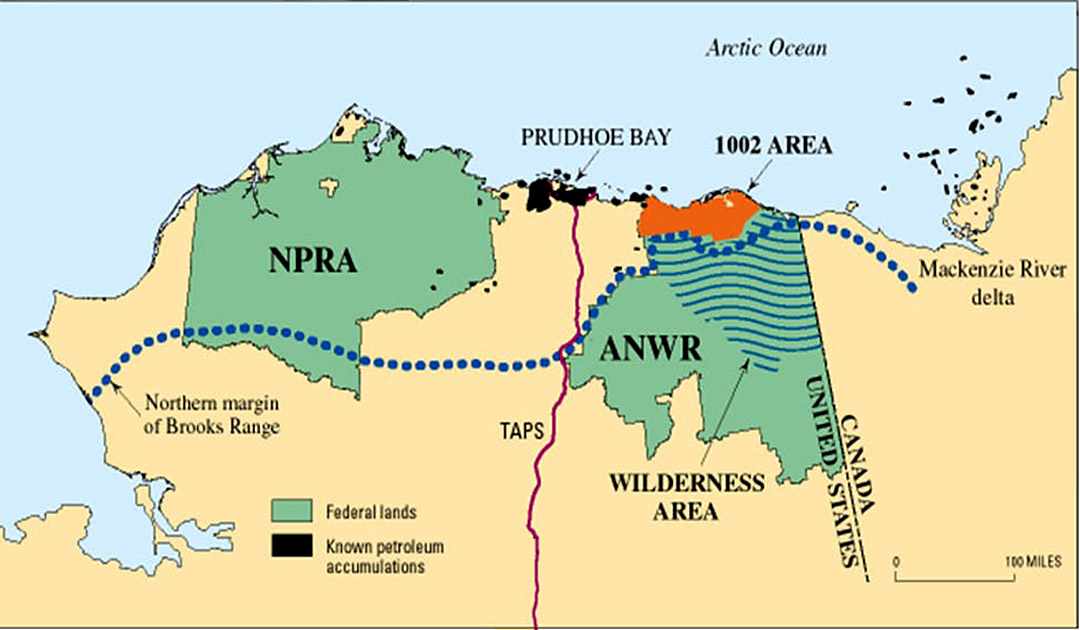
Three years ago, when the Trump administration announced that it would reopen drilling and extraction rights for oil and gas in the largest national protected Arctic area, an outcry of horror emerged from the ranks of environmentalists. Resistance was formed mainly from indigenous peoples such as the Gwich’in and environmental associations. However, on the other side were indigenous Inuit groups, such as the population of Kaktovik, who promised more jobs and infrastructure. This resulted in a tug-of-war between the factions. Now the Trump administration has hit the gas and wants to auction the leasing rights before the end of Trump’s term. But resistance again has accelerated.
Since last Tuesday, interested gas and oil extraction companies have been invited to submit their offers and spot requests where they want to extract the raw materials. These are the areas located on the North Slope, i.e. in the coastal area, of the Arctic National Wildlife Refuge (ANWR). This new round will remain open for the next four weeks, according to the government’s Bureau for Land Management. It could then publish a notice for the lease sale, which is necessary for the subsequent auction 30 days later. “Receiving input from industry on which tracts to make available for leasing is vital in conducting a successful lease sale,” Chad Padgett, the bureau’s Alaska State Director, said in a statement. This would allow the government to award the leasing contracts for extraction rights in the ANWR within the presidential term of Donald Trump. This has been a declared aim of the government from the start.

“We have been protecting this place forever.”
Bernadette Demientieff, Executive Director Gwich’in Steering Committee
But even this quick move by the Trump administration, which has caused a further outcry within the ranks of opponents, does not go unanswered. Powerful Inuit associations like the Gwich’in are combative. The executive director of the Gwich’in Steering Committee, Bernadette Demientieff, warned in a publication: “Any company thinking about participating in this corrupt process should know that they will have to answer to the Gwich’in people and the millions of Americans who stand with us. We have been protecting this place forever.” Environmental groups have already mobilised. For example, regional environmental associations have filed a lawsuit against a decision by the Bureau for Land Management for a extraction project. Such moves can reduce the administration’s ability to issue leasing contracts before The President-elect Joe Biden takes office. In general, experts doubt that the big companies will participate at all. The risk of further damage to the image and the massive costs of carrying out such a project in the first place are enormous. Companies are already struggling with falling oil prices and rising loss of face. Many major banks have already announced that there will be no credits to companies for such projects.

Nevertheless, there is no reason for optimism. Not all Inuit associations share the same opinion as the Gwich’in. In Kaktovik, a 250-people village in the middle of the disputed North Slope area, the Arctic Slope Regional Corporation does not want to bury plans for a possible fossil fuel extraction on their own. The association’s president, Rex A. Sock Sr., believes that this opportunity would bring jobs and could be done safely and responsibly, as The Washington Post writes. The aspect of jobs weighs heavily in the dispute over drilling rights. In Alaska, about a third of all jobs in the oil and gas industry have been lost since the beginning of this year due to falling prices and COVID. That’s just under 3,000 jobs, marking a low point in Alaska state figures. And a recovery is hardly in sight, an economic expert told Alaska Public Media.
In addition, the law is on the side of the proponents, as experts explain. Because the US Congress had passed a federal law in 2017, at that time still with a Republican majority in the House of Representatives. Joe Biden and his chief of staff, Ron Klain, have announced already that they will reverse policy decisions made by his predecessor, which could include extracting raw materials in the ANWR. But with a possible Republican majority in the Senate, this likely is to remain a difficult matter that the courts are will be allowed to continue to deal with, the laughing third party in this fight.
Dr Michael Wenger, PolarJournal
More on the subject:





